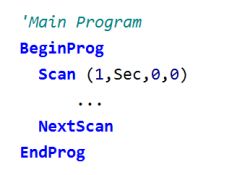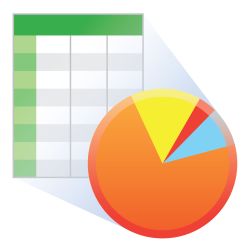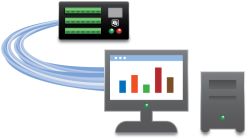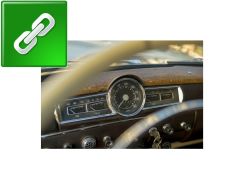This product is not available for new orders. We recommend ordering: CR1000X.
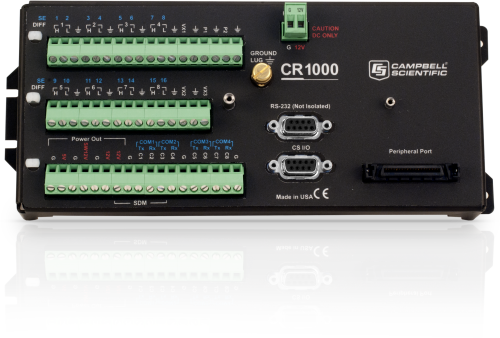
| Services Available | |
|---|---|
| Repair | Yes |
| Calibration | Yes |
| Free Support | No |
Overview
The CR1000 is our most widely used data logger. It can be used in a broad range of measurement and control functions. Rugged enough for extreme conditions and reliable enough for remote environments, it is also robust enough for complex configurations. Used in applications all over the world, it will be a powerful core component for your data-acquisition system.
Read MoreBenefits and Features
- Ideal applications include fire weather, mesonet systems, wind profiling, weather stations, air quality, ETo/agriculture, soil moisture, water level/stage, aquaculture, avalanche forecasting, time-domain reflectometry, vehicle testing, SCADA, and water quality
- Serial communications with serial sensors and devices supported via I/O port pairs
- Collects and stores data and controls peripherals as the brain of your system
- Flexible power and communication options make it ideal for remote locations.
- 4-MB memory can be expanded with add-on memory systems.
- Supports PakBus, Modbus, SDI-12, and DNP3 protocols
- Compatible with channel expansion peripherals allowing you to expand your system
- Program with LoggerNet, PC400, or Short Cut to fit your setup
- Communicates via various options: TCP/IP, email, FTP, web server.
- Gas Discharge Tube (GDT) protected inputs
- Battery-backed clock that ensures accurate time is maintained while data logger is disconnected from battery power
- Program and control on site with addition of CR1000KD keyboard and display unit.
- Contains custom ASIC chip that expands pulse count, control port, and serial communications capabilities
Please be advised that Campbell Scientific is nearing discontinuation of the CR1000 Measurement and Control Datalogger. The CR1000 will be available for order through 31 Jan 2020. You will not be able to purchase a CR1000 after this date. Refer to the CR1000 Discontinuation Notice for details.
Images













CAD Files:
Detailed Description
The CR1000 consists of a measurement and control module and a wiring panel. This data logger uses an external keyboard/display and power supply. Low power consumption allows the CR1000 to operate for extended time periods on a battery recharged with a solar panel—eliminating the need for AC power. The CR1000 suspends execution when primary power drops below 9.6 V, reducing the possibility of inaccurate measurements.
The CR1000's module measures sensors, drives direct communications and telecommunications, reduces data, controls external devices, and stores data and programs in on-board, non-volatile storage. The electronics are RF shielded and glitch protected by the sealed, stainless-steel canister. A battery-backed clock assures accurate timekeeping. The module can simultaneously provide measurement and communication functions. The on-board, BASIC-like programming language supports data processing and analysis routines.
The CR1000WP is a black, anodized aluminum wiring panel that is compatible with all CR1000 modules. The wiring panel includes switchable 12 V, redistributed analog grounds (dispersed among analog channels rather than grouped), unpluggable terminal block for 12 V connections, gas-tube spark gaps, and 12 V supply on pin 8 to power our COM-series phone modems and other peripherals. The control module easily disconnects from the wiring panel allowing field replacement without rewiring the sensors.
Originally, the standard CR1000 had 2 MB of data/program storage, and an optional version, the CR1000-4M, had 4 MB of memory. In September 2007, the standard CR1000 started having 4 MB of memory, making the CR1000-4M obsolete. Data loggers that have a module with a serial number greater than or equal to 11832 will have a 4 MB memory. The 4 MB data loggers will also have a sticker on the canister stating “4M Memory”.
Specifications
| -NOTE- | Additional specifications are listed in the CR1000 Specifications Sheet. |
| Operating Temperature Range |
|
| Analog Inputs | 16 single-ended or 8 differential (individually configured) |
| Pulse Counters | 2 |
| Voltage Excitation Terminals | 3 (VX1 to VX3) |
| Communications Ports |
|
| Switched 12 Volt | 1 terminal |
| Digital I/O |
|
| Input Limits | ±5 Vdc |
| Analog Voltage Accuracy | ±(0.06% of reading + offset) at 0° to 40°C |
| ADC | 13-bit |
| Power Requirements | 9.6 to 16 Vdc |
| Real-Time Clock Accuracy | ±3 min. per year (Correction via GPS optional.) |
| Internet Protocols | FTP, HTTP, XML, POP3, SMTP, Telnet, NTCIP, NTP |
| Communication Protocols | PakBus, Modbus, DNP3, SDI-12, SDM |
| Warranty | 3 years |
| Battery-backed SRAM for CPU Usage & Final Storage | 4 MB |
| Idle Current Drain, Average | < 1mA (@ 12 Vdc) |
| Active Current Drain, Average |
|
| Dimensions |
|
| Weight | 1.0 kg (2.1 lb) |
Compatibility
Note: The following shows notable compatibility information. It is not a comprehensive list of all compatible or incompatible products.
Software
| Product | Compatible | Note |
|---|---|---|
| LoggerNet | Version 3.0 or higher | |
| PC200W (retired) | ||
| PC400 | Version 1.2 or higher | |
| PCONNECT (retired) | Version 3.1 or higher | |
| PCONNECTCE (retired) | Version 2.0 or higher | |
| RTDAQ | Version 1.0 or higher | |
| Short Cut | ||
| VISUALWEATHER - Retired (retired) | Version 2.0 or higher |
Additional Compatibility Information
Sensors
With several channel types, the CR1000 is compatible with nearly every available sensor, including thermocouples, SDI-12 sensors, and 4 to 20 mA sensors (via a terminal input module, such as the CURS100). A custom ASIC chip expands its pulse count, control port, and serial communications capabilities. The CR1000's I/O ports can be paired as transmit and receive, allowing serial communications with serial sensors and devices.
Measurement & Control Peripherals
The CR1000 is compatible with all of our CDMs (requires an SC-CPI), SDMs, multiplexers, vibrating-wire interfaces, terminal input modules, and relays.
Communications
The CR1000 communicates with a PC via direct connect, Ethernet interfaces, multidrop modems, short-haul modems, phone modems (land line, digital cellular, and voice-synthesized), RF telemetry, and satellite transmitters (Argos, Iridium, and Inmarsat).
Data can be viewed on the CR1000KD Keyboard Display, the CD100 Mountable Display with Keyboard, an iOS or Android device (requires LoggerLink), CD295 DataView II Display, or a user-supplied PDA (PConnect or PConnectCE software required).
Compatible external data storage devices are the CFM100, NL115, and SC115.
Enclosures
The CR1000 and its power supply can be housed in any of our standard enclosures.
Power
Any 12 Vdc source can power the CR1000 datalogger. Power supplies commonly used with the CR1000 are the BPALK, PS150, and PS200. The BPALK provides eight non-rechargeable D-cell alkaline batteries with a 7.5 Ah rating at 20°C.
Both the PS150 and PS200 consist of a sealed rechargeable 7 Ah battery and a charging regulator. Their battery should be connected to a charging source (either a wall charger or solar panel). These two power supplies differ in their charging regulator. The PS150 has a standard regulator and the PS200 has a micro-controller-based smart regulator. The PS200's regulator provides two-step constant voltage charging and temperature compensation that optimize battery charging and increases the battery’s life.
Also available are the BP12 and BP24 battery packs, which provide nominal ratings of 12 and 24 Ah, respectively. These batteries should be connected to a regulated charging source (e.g., a CH100 or CH200 connected to a unregulated solar panel or wall charger).
Software
CRBasic, the CR1000's full programming language, supports simple or complex programming and many onboard data reduction processes.
Documents
Technical Papers
- FTP Streaming
- Benefits of Input Reversal and Excitation Reversal for Voltage Measurements
- Preventing and Attacking Measurement Noise Problems
- Voltage Measurement Accuracy, Self-Calibration, and Ratiometric Measurements
- DNP3 with Campbell Scientific Dataloggers
- BACnet to Modbus Protocol Conversion (App. Note: 1M-C)
- Irrometer 950R1-O/950T Radio Network (App.Note: 3MI-F)
- AlphaGUARD Radon Monitor Interfaced with the CR1000 Datalogger
- Serial Sensors: Interfacing with CSI Dataloggers (App. Note Code: 2MI-V)
- CF Card Information (3SM-F)
Case Studies
Compliance
Miscellaneous
Videos & Tutorials
Downloads
CR1000 OS v.32.07 (4.60 MB) 15-05-2024
Execution of this download installs the CR1000 Operating System and Compiler on your computer. It also updates the CR1000 support files for the CRBasic Editor.
Note: This OS has crossed the 2 Meg CR1000 size limit for remote download. The OS must be downloaded to the 2 Meg CR1000 via direct connect with the Device Configuration Utility. All OS download methods are supported by the 4 Meg CR1000.
Upgrading from versions prior to version 28 of the Operating System will reset the datalogger’s CPU drive. This is due to a change in the format of the file system from FAT16 to FAT32. In order for the datalogger to operate correctly, as part of the upgrade, the CPU drive is formatted to FAT32. Any programs stored and running from the CPU drive will be lost. It is not recommended to update the datalogger’s Operating System over a remote connection where program control regulates the communication equipment (turning it on or off, etc.). In these cases, an on-site visit and a backup using DevConfig’s backup utility is necessary to update the datalogger’s Operating System.
Watch the Video Tutorial: Sending an OS to a Local Datalogger.
In all cases where the datalogger is being updated from an Operating System prior to 28, the use of DevConfig’s backup utility is recommended due to the CPU drive being formatted using the new FAT32 format.
Device Configuration Utility v.2.33 (49.6 MB) 07-07-2025
A software utility used to download operating systems and set up Campbell Scientific hardware. Also will update PakBus Graph and the Network Planner if they have been installed previously by another Campbell Scientific software package.
Supported Operating Systems:
Windows 11 or 10 (Both 32 and 64 bit)
Frequently Asked Questions
Number of FAQs related to CR1000: 164
Expand AllCollapse All
-
Yes. Create a multidrop network with an MD485 between the CR5000, the CR1000, and the digital modem. See the “Digital Cellular Modem to MD485 Network” appendix item in the MD485 instruction manual.
-
Yes. Control terminal pairs may be configured as full duplex asynchronous RS-232/TTL serial terminals. See the data logger manual for details. For additional details on interfacing RS-232 sensors, see the "Interfacing Serial Sensors with Campbell Scientific Dataloggers" application note.
-
Yes. Each COM port has individual settings and buffers.
-
The data logger’s Status table has a LastSystemScan field that provides this information.
-
In OS 24, the data logger does not differentiate between a self-signed and a signed certificate.
-
Yes. The CR1000 could be set up as a SDI-12 sensor using the SDI12SensorSetup() instruction. Alternatively, the CR1000 could be set up to perform serial communications with the CR3000 by connecting a COM1─COM4 port pair and ground from one data logger to a COM1─COM4 port pair and ground on the other data logger. The COM1─COM4 port lines need to cross RX to TX and vice versa.
-
The lithium battery voltage is measured by the data logger once per day, and the value is held in the Status table when it is running normally. The voltage is normally extremely stable if the data logger is powered from another source and its temperature is stable. A new battery supplies approximately 3.6 Vdc; it should be replaced when its reading is at or below 2.7 Vdc.
The lithium battery voltage is also read when the data logger is reset or its program is recompiled.
-
No. Only a program change could cause this. To save data to a CFM100 or an NL115, a CardOut() or TableFile() instruction must be present in at least one data table.
-
Yes. The data logger needs to be programmed to use FTP.
Case Studies
Tropical volcanic islands are biodiversity hotspots where the Critical Zone (CZ) remains poorly studied. In......read more
Agrivoltaics or dual-use solar is a system combining an agricultural crop (viticulture, arboriculture, field crops,......read more
In August 2012, RESPEC was contracted to provide field instrumentation and early-warning monitoring services at......read more
The drawings and engravings of the Chauvet Cave not only demonstrate an exceptional artistic and......read more
America currently has an estimated 75,000 tons of spent nuclear fuel housed at dozens of......read more
Intelligent Infrastructure Systems, a Pennoni company, was contracted to design and install an efficient structural-health......read more
With climate change and pollution becoming important issues globally, it is important for governments and......read more
Severe Tropical Cyclone Debbie was a category 4 system that made landfall near Airlie Beach......read more
Articles and Press Releases
Newsletter Articles
- Celebrate with Us! 24-01-2018
- Case Study: PGA Tour Lightning Warning System 28-10-2016
- Case Study: High-Elevation Weather in Peru 21-07-2016
- Case Study: Geothermal Development in Colombia 02-02-2016
- Case Study: Dam Monitoring in Puerto Rico 02-02-2016
- Case Study: Webcams in New Hampshire Forest 15-10-2015
- Case Study: University of Toronto Green Roof Research 21-07-2015
- Case Study: Cavern Collapse Alarm 21-07-2015
- Case Study: Washington AgWeatherNet 14-04-2015
- Case Study: South Africa Solar Prospecting 14-04-2015
- Powerful New Operating System for CR800, CR1000, CR3000 04-02-2015
- Case Study: Solar-Energy Assessment in Chile 20-10-2014
- Case Study: Florida Endangered Species 30-07-2014
- Case Study: South Dakota Irrigation Update 30-07-2014
- Case Study: Flood Warning in Arkansas 15-10-2013
- Case Study: Preventing Road Damage from Freezing Conditions in South Korea 09-05-2013
- Case Study: Florida Water Diversion Control 18-10-2012
- Case Study: North Carolina “Green” Hotel 18-10-2012
- Case Study: Station Provides Flood Warning & Road Weather Data 17-08-2012
- Case Study: Researching Glacier Retreat in the Andes 17-08-2012
- New Operating System for CR800, CR1000, CR3000 17-08-2012
- Case Study: Water-Supply SCADA System 15-03-2012
- Case Study: Post-Tensioned, Fiber-Reinforced Bridge 16-11-2011
Privacy Policy Update
We've updated our privacy policy. Learn More
Cookie Consent
Update your cookie preferences. Update Cookie Preferences






